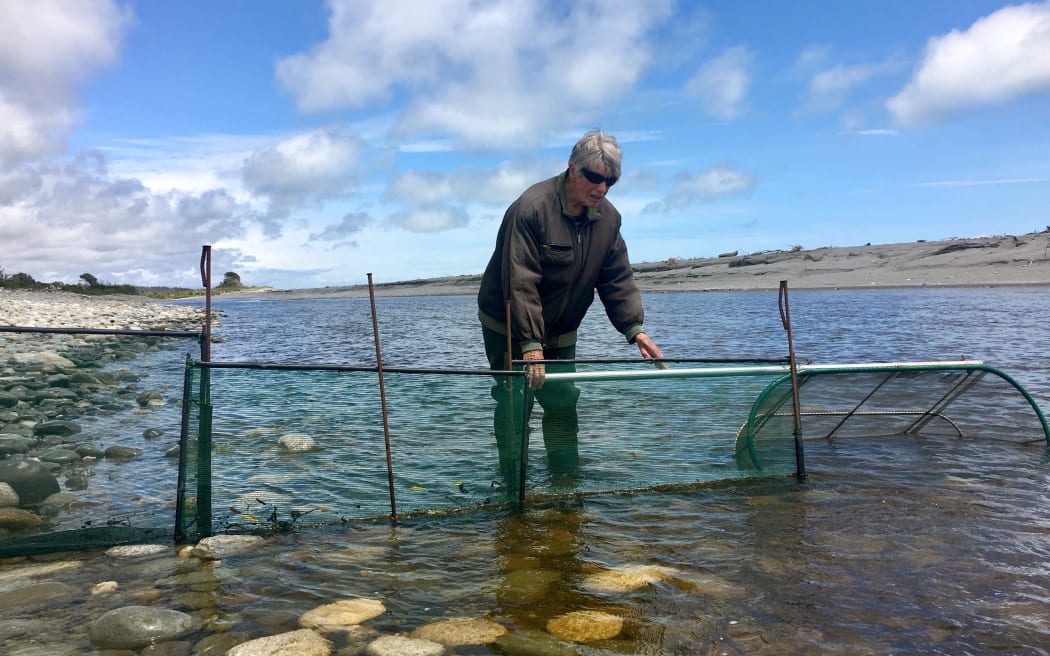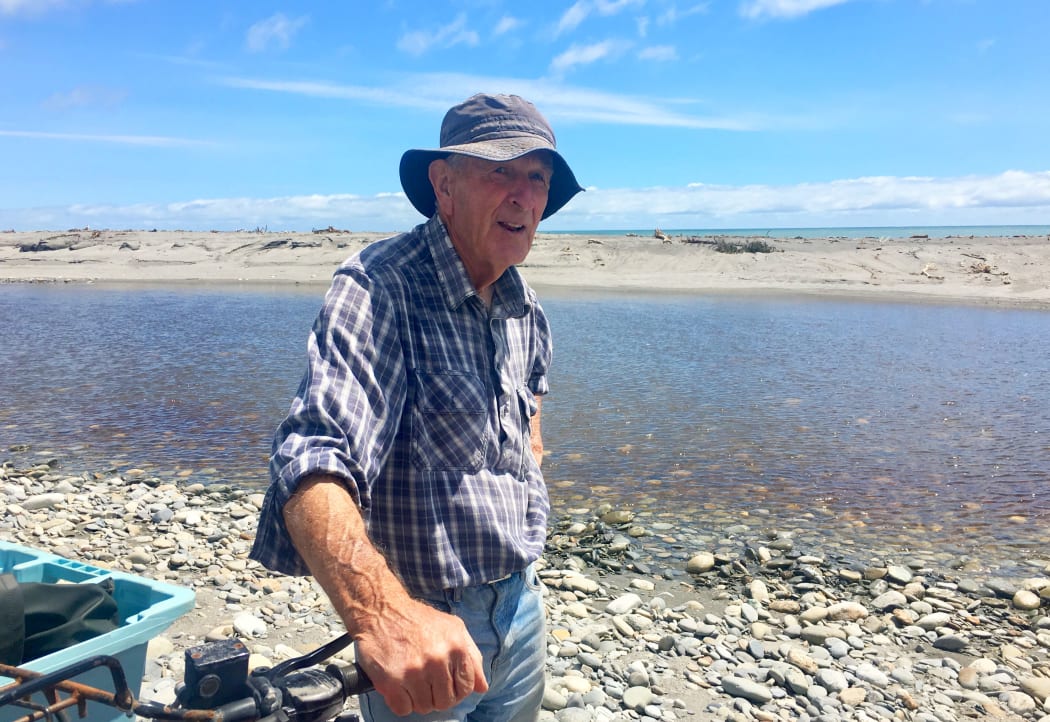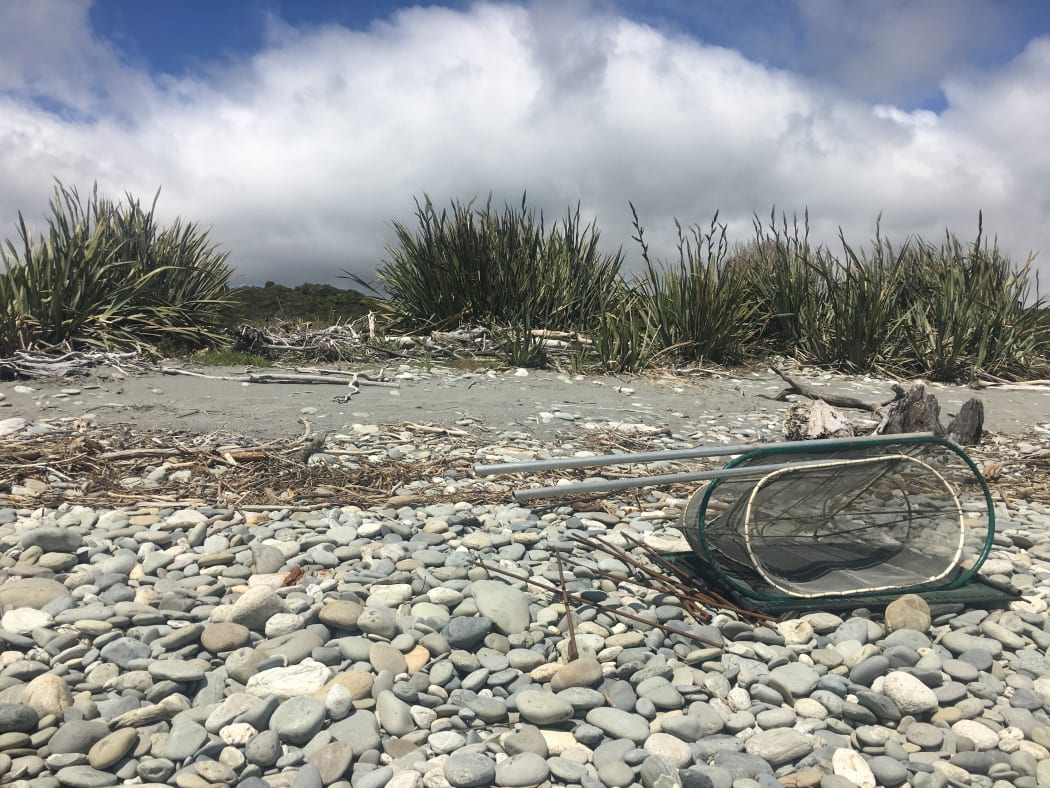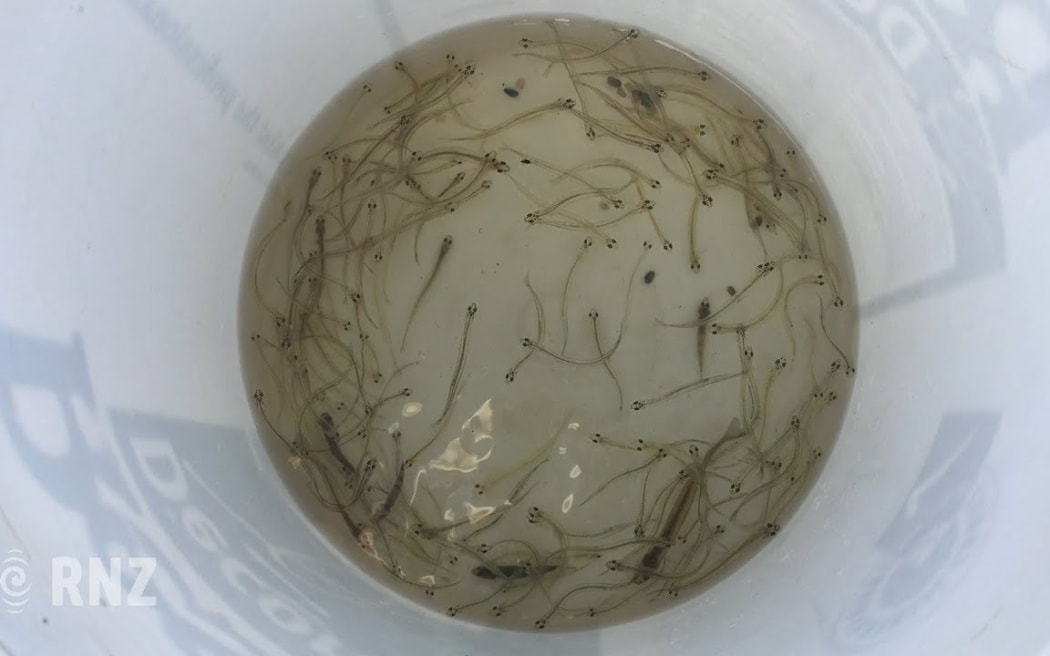Insight - Four out of five species whose juveniles make up the whitebait catch are in decline or under threat. Insight's Teresa Cowie heads to the West Coast to find out why and what needs to change.

Janice Whitebaiting near Hokitika at her secret location Photo: RNZ Insight/Teresa Cowie
At their closely guarded whitebaiting spot near Hokitika, Des McEnaney and Janice Davia are making the most of the last few days of the season, scouring the blacksand river mouth for shoals of whitebait.
It's a white-knuckle quad bike ride to get here, bouncing around on the back with nets and an old paint bucket waiting to be filled with the bait.
"Yeah, a bit rugged" Des jokes, dryly.
I'm warned things won't end well for me if I reveal this prime bit of whitebaiting real estate to all and sundry, so I hastily make assurances I'll take the precious co-ordinates to my grave, (later rather than sooner).
We grab the old paint bucket, place it next to the net and wait for a shoal of the tiny silver-eyed wrigglers to take an ill-advised turn into the net.
Whitebaiting - a way of life
For Hokitika locals, like Des and Janice, whitebaiting is more that just a feed or a bit of extra money in their wallets, it's a way of life and an important part of their identity as Coasters.
Des has been whitebaiting since he was 11 and Janice took it up as an adult; she describes the thrill of filling the net as 'an addiction'.
Whitebait is an important part of the West Coast barter system of sharing that "bit extra" you have with others, she says.
"I give it away to my friends, we've got a fella, he brings us firewood and meat off his farm, so I give him whitebait."
But she says when it comes to sharing information with the government about her catch, there's no chance.
"I don't know if I'd bother to tell them if I had good catch...No, I wouldn't, there'd be a lot of people who wouldn't tell them exactly how much they caught, if you caught 10 tonne would you tell them?"
She says if the government wants data, it can send it's own researchers to gather it.
Subscribe free to Insight On iPhones: Apple Podcasts, RadioPublic or Spotify. On Android phones: RadioPublic
Whitebaiting is possibly New Zealand's most unregulated fishery, and currently ideas ranging from banning commercial fishing, to quotas, to licencing fishers and having them fill in catch diaries are all up for discussion.
With so little research available into why they are declining it's thought asking fishers how much they catch, and where, may help with filling in the gaps.
But whitebaiters are notoriously secretive about their favourite spots and how well they are doing.
Des however says a licencing system and having to fill in a catch diary could be a good thing if they are done well.
At upwards of $80 a kilogram, whitebait is a luxury good and an easy side-earner for anyone who can get their hands on a net and a copy of the tide chart.

Des McEnaney has been whitebaiting since he was 11 Photo: RNZ Insight/Teresa Cowie
However, some whitebaiters say there are more people flooding into the area to make a quick buck, and that creates an element of 'greed over a feed'.
Des McEnaney said a licence for whitebaiters could help stamp out dodgy operators who don't follow the rules.
As for catch diaries - would whitebaiters co-operate and fill it in accurately?
"Yes, they would if they knew it would be treated confidentially and didn't come back to bite them, if it wasn't used as a system of quota then they would be quite happy. You need the goodwill of whitebaiters because we need the research," Des said.
He would like to see any revenue from licencing put back into researching whitebait decline and how it can be remedied.

Photo: RNZ Insight/Teresa Cowie
The Department of Conservation say the research it does have on the fully grown adult whitebait shows they are just not being seen in their upriver breeding grounds in the numbers they used to be.
Of the five species whose juveniles make up the whitebait catch, the native Banded kōkopu appears to have healthy populations, Giant kōkopu, Inanga and Kōaro are in decline, while Shortjaw kōkopu are threatened.
What are whitebait?
The tiny fish caught each spring by whitebaiters are the juveniles of the five species of adult whitebait, also known as migratory galaxiids - a name inspired by the silvery glitter-like flecks that pattern their skin like a galaxy of stars.
Depending on the species they can grow to maturity at anywhere between 10 and 60 centimetres.

The life cycle Īnanga one of the 5 species of whitebait Photo: Te Ara - the Encyclopedia of New Zealand, http://www.TeAra.govt.nz
A recent report looking at what is and isn't known about why they are in decline can identify some things that may be putting them at risk, but with the current level of understanding scientists can't pinpoint exactly what poses the greatest threat.
The nets that line rivers for three months every spring are not the only potential obstacle to the successful breeding of whitebait.
The Department of Conservation also puts the decline down to intensification of farming and building developments near waterways leading to a lack of clean, tree-shaded rivers and streams for the adult fish to lay their eggs in.
It said barriers like dams and culverts in our roading network block whitebait from reaching their breeding grounds up river.
Introduced fish like gambusia and trout also prey on whitebait and muscle them out of their habitat.
Climate change, bringing rising water temperature and extreme weather and flooding - which changes the physical shape of their breeding grounds - is also thought to be making an attack on whitebait's ability to thrive.

Photo: RNZ Insight/Teresa Cowie
Des McEnaney is worried that although whitebait decline might be caused by poor water quality, climate change or habitat loss, the easiest and most obvious way to go would be to tighten regulation on whitebaiting.
"You can regulate until you hat comes off, but if you do not address those core issues (destruction of habitat) you have wasted your time."
"I'm worried that the politicians will pick- up on an easy-out that does not cost them a lot of money and won't properly address the problems the bait have when they go in to breed (and that's not the fishing)".
Des said he doesn't blame farmers and understands that planting and fencing along waterways is a huge undertaking that they should get support to do.
The Conservation Minister Eugenie Sage said she has no intention of taking an 'easy out' on protecting whitebait.
"I have asked the Department of Conservation to do an issues and option document and get public feedback on what are the key issues on ensuring that we have healthy whitebait populations and a sustainable fishery."
But she wouldn't be drawn on whether tighter regulation for fishers is on the cards.
"I am yet to see the issues and option document so I am not going to predict what's in it."

A notice in the Hokitika Guardian informing locals of the whitebaiting drop-in sessions Photo: RNZ Insight/Teresa Cowie
12 drop-in discussion sessions have been held around the country, to gather feedback from whitebaiters and all of those concerned about the decline of the species.
400 people with an interest in whitebaiting made their voices heard at the sessions which have now concluded, another 2,500 have filled in a survey looking at Improving Whitebait management.
Consultation and the online survey will close to the public on 7 January 2018.


